Technology for laying a warm floor under a tile - 10 steps to success
Which option to give preference?
The heating of the floor covering from the network can be represented by a heating cable or a thermomat. On the advantages and disadvantages of each of types of electric underfloor heating We spoke in detail in the corresponding article. Now let's talk briefly about which option is better to choose.
Electric underfloor heating from a cable under a tile is cheaper, but at the same time, calculating its length and the installation itself are more difficult. It is recommended to use it if you can sacrifice the height of the ceiling (because the screed will be thicker).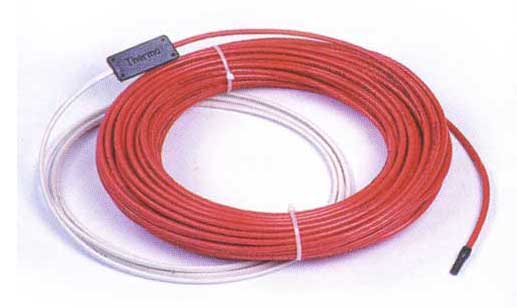
As for the heating mat, it has several advantages, as in fact, it is an improved version of Explorer. The design feature is that the same cable is already placed on a special fiberglass mesh, which allows you to withstand an even step between the turns.
In addition, the convenience of the thermomat is that for calculating the material, it is only necessary to calculate the area of the room and, based on this parameter, choose a roll of a suitable size.
Which of the options to give preference to is up to you, but we still advise you to use the laying of an electric mat, moreover, this option has many positive reviews on the Internet.
Styling technology
In this article, we will consider laying a warm electric floor under a tile using a heating cable, as well as a special mat. The preparatory work will be similar, the difference will only be in the main process.
Prepare the surface
First you need to remove the old flooring and clean the surface of debris. If there are no defects, you can do without a screed (draft). In the event that the floor has irregularities, it is necessary to initially level them with a solution of a thickness of 3 to 7 cm.
Schema creation
Before the calculation work, it is necessary to draw up a connection diagram for the electric underfloor heating under the tile, on which the step of laying wires or a heating mat is noted.
Recommendations for drawing up a scheme:
- at least 10 cm should be retreated from the walls;
- in the places of installation of furniture without legs, as well as household appliances, it is forbidden to lay the material (heat transfer will be difficult, and all warm air will return back to the conductor, which will cause it to overheat and fail);
- it is not necessary to lay the material in a straight line, you can carefully trim the grid to bend the track in the right direction (this option allows you to reduce energy consumption, focusing heating only on the necessary areas).
Material calculation
If you decide to make a warm floor under the tiles with your own hands as the main heating, it is necessary to carry out the calculation taking into account that at 1 m2 you will need a heater with a power of at least 140-180 watts. For auxiliary heating system, you can use power, not more than 140 W / m2 (80 W is possible, it all depends on how high-quality insulation of the room is made).
All you need is to calculate the area of the room (length * width) and subtract from this value the area occupied by furniture without legs and household appliances (since it is forbidden to lay material under them). As a result, you will get a useful heating area. After that, based on the result obtained, the required total power of the heating element and its length are determined. The linear power of one meter of the heating cable can vary from 16 to 21 W / m.
For example, if the area of the room is 10 m2 and you chose a heater with a power of 100 W / m2, then the result is the total required power of 1 kW. We select a cable of 20 W / m, the length of which should be 50 m (1000/20).
The thermomat is selected according to the same principle, based on the usable area and the required power. In addition, it is necessary to purchase a mounting tape, with the help of which the heater will be mounted to the concrete screed.
Checking old wiring
As you understand, for a room with an area of 25-30 m2 you need a sufficiently powerful electric underfloor heating floor, which will have a noticeable load on electrical wiring in the house. You have to exercise cable cross section calculation and determine if your wiring is suitable for the new heating system. If it turns out that the diameter of the cores does not match, it is necessary to replace wiring in the house to a new, more powerful one. Also check that the circuit breaker and the RCD correspond to the new current load.
Thermal insulation
Now we proceed to installation and the first thing to do is to qualitatively insulate the surface for laying an electric heated floor. The effectiveness of the use of the system, as well as its efficiency, will depend on this. In this case, penofol is considered the best insulation material - a rolled material with a self-adhesive layer and a foil coating. All you need is a butt joint to glue the entire concrete surface, and then seal the joints with foil tape. It should be noted that penofol should go on the walls for several centimeters in order to increase the thermal insulation of the room.
If you want to slightly reduce the height of the room, then instead of penofol you can put another insulation, for example, polypropylene or expanded polystyrene.
At the end of the robot, it is recommended to glue a damper tape on the top of the insulation on top of the insulation, the purpose of which is to compensate for the expansion of the coating when heated. It is also necessary to put a metal mesh on top of the insulating layer, which will prevent direct contact with the heater and will simplify the process of installing an electric heated floor under the tile.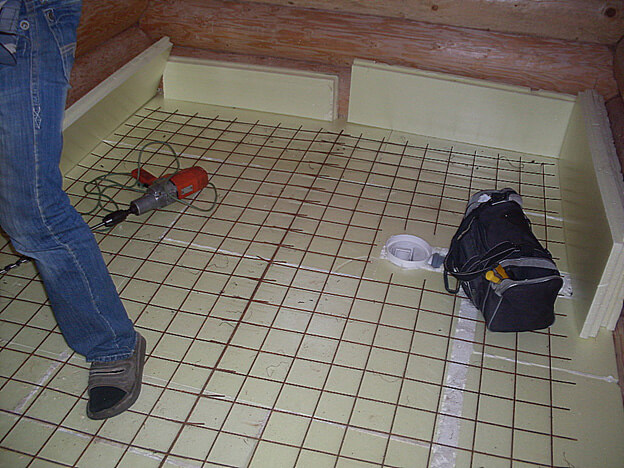
Temperature Sensor Installation
To monitor and control the system, it is necessary to install a special thermostat and a temperature sensor.The thermostat is a regulator (mechanical or electronic) with which you can set the optimum temperature, as well as the time the system is turned on / off. It is mounted in the wall, next to sockets.
As for the temperature sensor, it needs to be installed in the floor itself. To do this, a special gate is created in the wall from the thermostat, which is strictly vertically directed to the ceiling. Further, the sensor is placed in a corrugated pipe and is led to the place of temperature control of the electric underfloor heating under the tile. This place is the middle between two turns of cable, while there should not be any intersections near. Corrugation protects the sensor from damage, and also allows you to provide access to it at any time (for example, when it fails). For the end of the corrugation, which will be in the screed, for reliability, it is recommended to fill with sealant so that the solution does not get inside.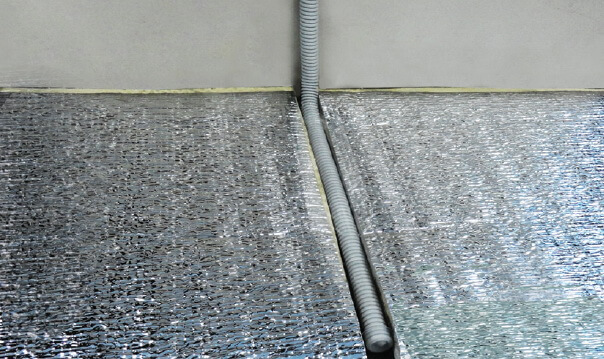
Heater check
Before laying the cable (or mat), it is necessary to measure its resistance. This value should not differ from the passport data by more than 10%. To do this, use a special device - a multimeter (shown in the photo below), which also determines where the phase, if not wire color marking. If the resistance corresponds to the nominal, then it is possible to install an electric heated floor under the tile.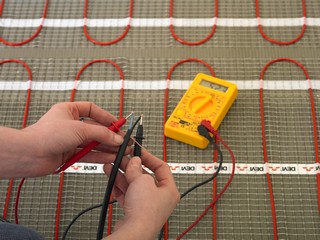
Fastening the cable (or thermostat)
Now that the surface is already completely prepared, it is necessary to fix the heating element. If you use a cable, fasten it using the mounting tape, as shown in the photo:
In this case, it is also recommended to use plastic clamps, which will make the process of attaching an electric heated floor under the tile easier and faster.
The distance between the turns should be the same throughout the area, otherwise the electric floor heating will be uneven. Heating mats are easier to install. the distance between the turns is maintained along the entire length. All you need is to spread the material according to the diagram and connect it correctly to the thermostat.
When the installation of the electric underfloor heating under the tile is completed, it is necessary to check the correct connection by measuring the resistance with a multimeter. The resulting value should match the one you measured before laying.
Pouring screed
In order to make a concrete mortar you need to prepare the following ratio of materials:
- 4 parts of sand;
- 1 part of cement;
- 5 parts of crushed stone;
- 0.6 parts of water;
- 1% by weight of cement of a special plasticizer (gives a solution of elasticity).
It should be noted that the amount of water should be small, otherwise cracks in the screed may occur. As for expanded clay and perlite, they are strictly forbidden to add to the solution, because These materials interfere with heat transfer and are one of the causes of conductor overheating.
The thickness of the screed cake should be from 3 to 5 cm. It is not recommended to go beyond these values. After pouring, you must wait until the solution solidifies completely. Despite the fact that the screed hardens in a couple of days, its complete drying will occur only after 4 weeks (or maybe more). Until this time, it is prohibited to turn on the electric underfloor heating.
We also draw your attention to the fact that a screed is required only if a heating cable is used. The thermomat can immediately after laying serve as the basis for tile adhesive.
Laying tiles
After the screed is seized (2-3 days), you can waste no time moving to the floor with tiles. It is recommended to do this only if you have experience, because you need to ensure that the surface is strictly horizontal. The tile "sits" on a special glue, after which the installation of an electric heated floor under the tile is considered finished!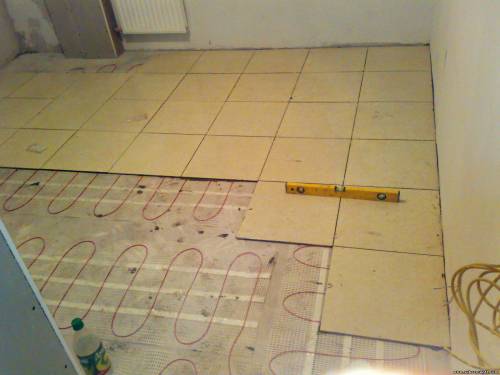
That's the whole do-it-yourself styling technology. We recommend that you watch a video in which you can see some of the nuances of the event:
Also read:

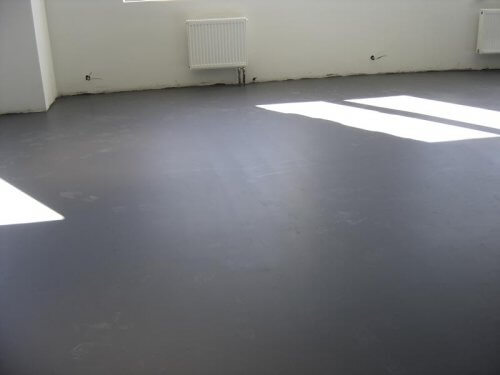
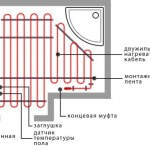
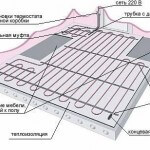
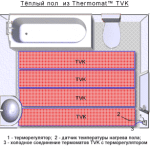
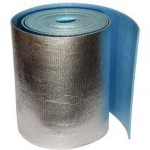
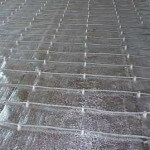
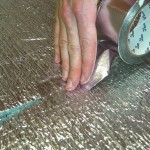
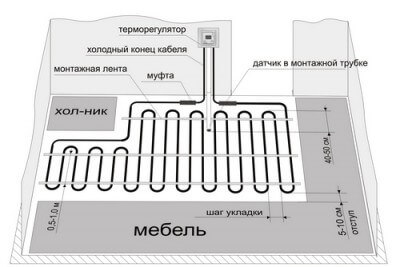
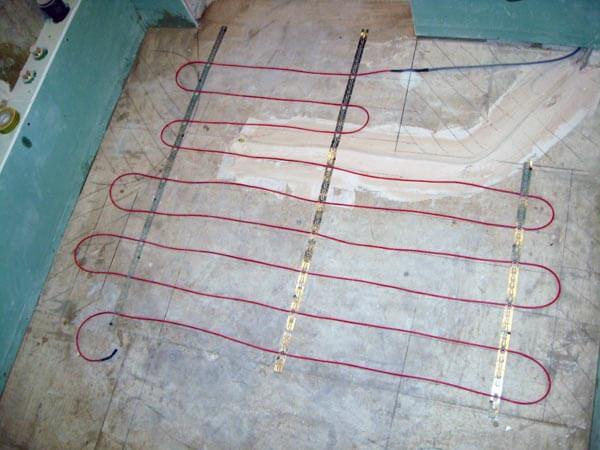
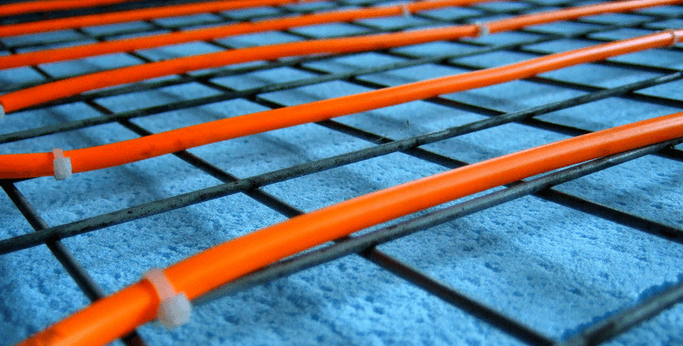
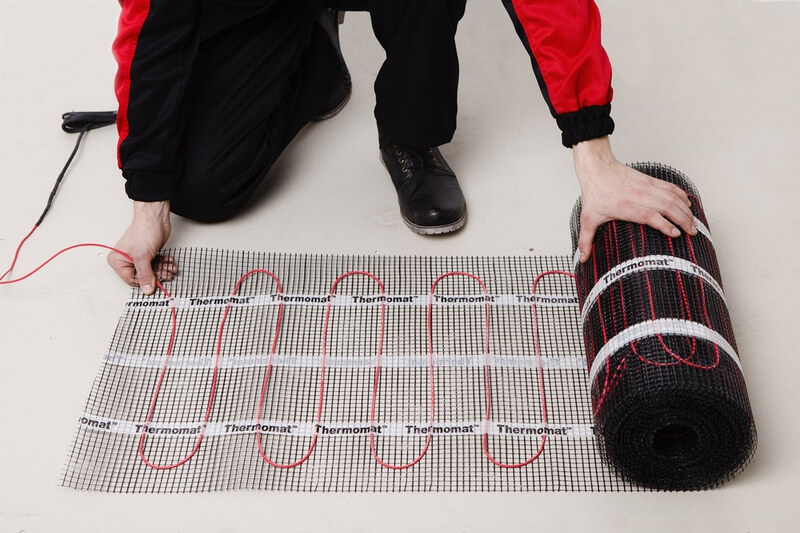
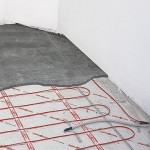
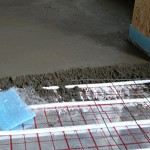
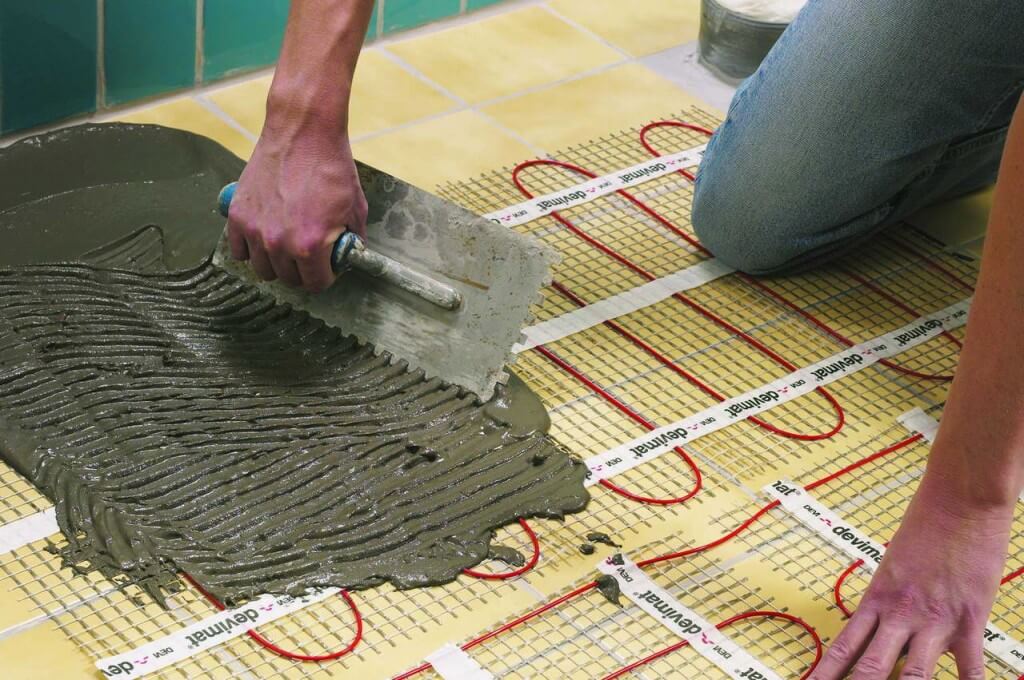



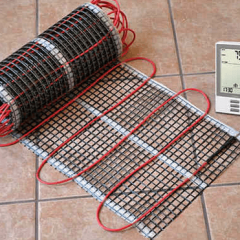
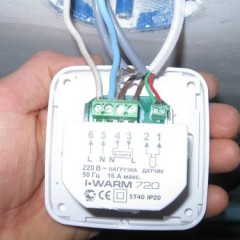
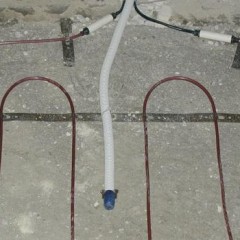

Hello. Tell me please. a rough screed was flooded before they decided to lay down an email. floor. in this case, the cable. the foam is laid under the screed is not laid. is it possible now to lay down polystyrene foam then foil then an electric cable and then pour the final screed. otherwise it doesn’t work out. above the door frame threshold is obtained. Ceramics will be laid. tile
“Polystyrene is not laid under the screed” - it’s a little incomprehensible what you wanted to say by this. In general, you can do as they wrote. The temperature of the warm floor will not damage the foam, especially if foil is laid on top of it. Finishing screed also does not affect the so-called “pie”. The only question is “why do you need polystyrene at all?”
Tell me please. The screed is flooded during the construction phase of the apartment. I want to make a warm floor in the bathroom (157 × 179) and the toilet (158 × 177). But only 1 sq.m in the toilet and 1 sq.m in the bathroom will be heated, actually in front of the bathroom and in front of the toilet, in the corresponding rooms. It was thought to lay a cable through the wall in both rooms, on one thermostat. Everywhere tiles on the floor. But it turned out that the cable was only for screed. What to do? To fill in a coupler from above? Can't cable for tile adhesive?
Good evening! Of course you can, there is a special thin heating cable for tile adhesive. Here I recommend using it.
Good afternoon! Please tell me how to do it: there is a rough screed, from it to the floor level 5 cm. I suppose putting penoplex -2 cm, then penofol + warm mat -1.5 cm and then the tile on the glue also 1.5 cm. Is it possible? Or is it somehow different? the main thing is to maintain the size of the whole pie 5 cm.
1cm extruded polystyrene
Mesh floor heating mesh, 3cm screed reinforced with fiber, tile adhesive
There is no need in foil; no, it will not stick to one glue, and a 3cm screed without mesh and fiber is also not able to withstand.
Option only for a small room: bath, toilet; for a large room, the screed should be 5cm and the insulation is preferably thicker
Hello! All right!
Good afternoon! Tell me how to put a warm floor in the bathroom? What gender and in what order? Base moisture resistant GVL. Thank.
Good day, Michael! You can make a warm floor under the tile using a heating cable or thermomats. Instructions for laying heating elements in the bathroom are provided here - http://my.electricianexp.com/en/texnologiya-ukladki-teplogo-pola-pod-plitku-10-shagov-k-uspexu.html As for the base from GVL, in the case of thermomats, it is recommended to simply place the mats on the glue, as usual. For heating cable, it is better to make special grooves.
A question. For the greenhouse, a track in the center and 2 side walls. Under a flagstone, which cable will work best. And subsequently whether it will strike an electric current.
It will not knock if everything is done correctly. Buy a heating cable designed for the street. For example, resistive cable DVT-20 or self-regulating DVU 33.
Good afternoon! Tell me, please, before laying the heating mats, it is also necessary to lay penofol? And do you need to primer a concrete screed before this? (Floor in the bathroom in a private house under the tile). Thank!
Hello. In the hallway I want to install a warm floor, e.the wiring in the apartment is divorced on the floor and in the place where there will be a warm floor, the largest number of wires passes. How to do it right?
P.S. screed is already flooded on top of the wires. Thank!
There are two options:
1. Discard the warm floor.
2. Divide into sections and to install a warm floor not closer than 15 cm from the channel with wires.
I want a warm floor in the bathroom, wooden floors, with thick plywood poured from the top, please tell me the installation sequence along with insulation and waterproofing to get a minimal layer of “pie”. thank
Please tell me what kind of wire mesh should be laid under the heating cable !? Do not quite understand.
Please tell me in a country house I want to lay a warm floor with a cable. The preparatory “cake” of the floors on the ground consists on the soil laid out 15 cm of pressed sand-and-mortar waterproofing (polythene 2mm) 5-7cm again sand-and-mortar (not pressed) then after 5-7 cm reinforcement with 32 reinforcement begins on the 4th floor of the building (cell about 15- 20cm) the total thickness of concrete is 30cm with an internal reinforcement of about 12-13cm (groundwater is close at times less than 2 meters) So the question is whether it is possible to lay a cable on the concrete screed and glue the tile. If so, what are the conditions. If not, what to add ???
what should be the temperature of the electric floor, if you put the tiles on top?
There is a special tile adhesive that can withstand the desired temperature
Hello!!! Your advice is very necessary! Please tell me, there is a cement-sand screed in the entire apartment, level 0, after we made the screed we decided on an electric heated floor. Tile finish. What is better to put mats? or cable? one more screed is not ready for the floor in the whole apartment on the same level. and the underfloor planning kitchen-bath. How to lay mats or cable without another tie? Thanks in advance.
Please tell me, is it possible to use a mat on a heating cable, lay down the tile right away ???